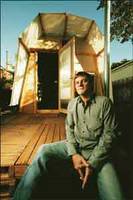Friday, June 10, 2005
Thinking outside (but living inside) the box
Paul and I sometimes joke that, were we ever to move back to the California Bay Area, we could afford to buy a refrigerator box under a highway. When we're feeling good about the value of our house in Seattle, we think that we could get a nice new box, from a large refrigerator, and that we could manage an overpass in a good neighborhood.
Today I read this article about an Australian architect who has designed a housing system that is made mostly of cardboard (with some plywood "framing"). The houses can be flat-packed, and therefore are easily shipped. It should be great disaster relief housing; plans are in the works to send several of the houses to East Timor later this year.
 From the article:
From the article:
According to architect Peter Ryan, these houses might be a solution for people who couldn't otherwise afford to buy in Melbourne's hot real estate market... or, I'm thinking, for those of us who might one day want to live in the Bay Area again.
Today I read this article about an Australian architect who has designed a housing system that is made mostly of cardboard (with some plywood "framing"). The houses can be flat-packed, and therefore are easily shipped. It should be great disaster relief housing; plans are in the works to send several of the houses to East Timor later this year.
 From the article:
From the article:Living in a cardboard box has never looked so good.Read the whole article (without registering at yet another newspaper website).
Melbourne architect Peter Ryan's clever but simple design for a house made largely from cardboard could prove revolutionary. With applications in temporary housing and particularly in disaster relief, the structures are inexpensive, easily assembled and surprisingly durable.
The concept of a cardboard house sounds almost inconceivable but it works. The basic structure is a series of pods made from plywood - cardboard panelling is used in the roof, walls and floors. The cardboard panels are the same size as a standard cardboard box, and the houses can be as small or as large as required; pods are simply added either up or out.
According to architect Peter Ryan, these houses might be a solution for people who couldn't otherwise afford to buy in Melbourne's hot real estate market... or, I'm thinking, for those of us who might one day want to live in the Bay Area again.


 Music and Cats
Music and Cats